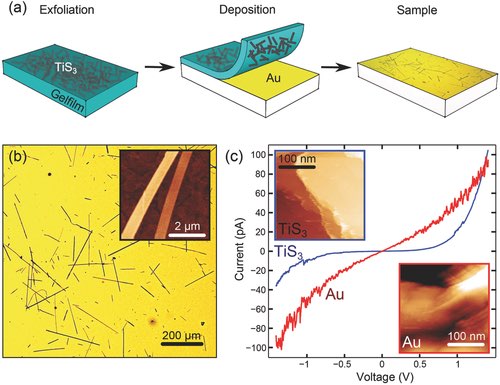A study of the electronic and optical bandgap is presented in layered TiS3, an almost unexplored semiconductor that has attracted recent attention because of its large carrier mobility and inplane anisotropic properties, to determine its exciton binding energy. Scanning tunneling spectroscopy and photoelectrochemical measurements are combined with random phase approximation and Bethe–Salpeter equation calculations to obtain the electronic and optical bandgaps and thus the exciton binding energy. Experimental values are found for the electronic bandgap, optical bandgap, and exciton binding energy of 1.2 eV, 1.07 eV, and 130 meV, respectively, and 1.15 eV, 1.05 eV, and 100 meV for the corresponding theoretical results. The exciton binding energy is orders of magnitude larger than that of common semiconductors and comparable to bulk transition metal dichalcogenides, making TiS3 ribbons a highly interesting material for optoelectronic applications and for studying excitonic phenomena even at room temperature.

A study of the electronic and optical bandgap is presented in layered TiS3, an almost unexplored semiconductor that has attracted recent attention because of its large carrier mobility and inplane anisotropic properties, to determine its exciton binding energy. Scanning tunneling spectroscopy and photoelectrochemical measurements are combined with random phase approximation and Bethe–Salpeter equation calculations to obtain the electronic and optical bandgaps and thus the exciton binding energy. Experimental values are found for the electronic bandgap, optical bandgap, and exciton binding energy of 1.2 eV, 1.07 eV, and 130 meV, respectively, and 1.15 eV, 1.05 eV, and 100 meV for the corresponding theoretical results. The exciton binding energy is orders of magnitude larger than that of common semiconductors and comparable to bulk transition metal dichalcogenides, making TiS3 ribbons a highly interesting material for optoelectronic applications and for studying excitonic phenomena even at room temperature.
